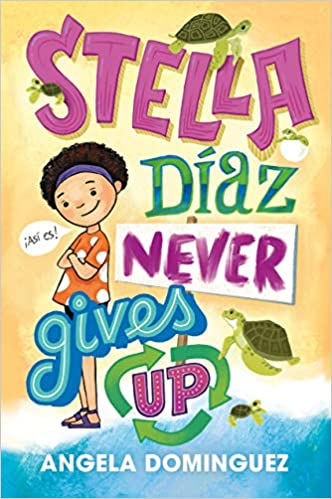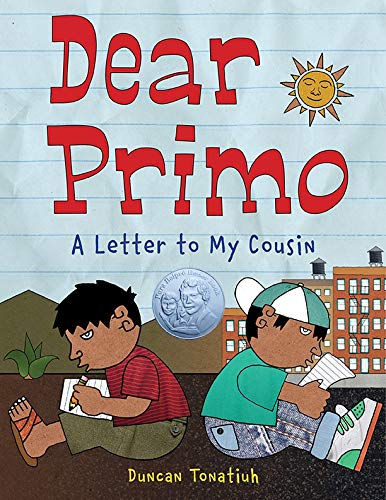Stella Diaz Never Gives Up & Dear Primo: A Letter to My Cousin
- Lauren Vines
- Aug 31, 2020
- 5 min read

In last week's post, I wrote about We Are Water Protectors by Carole Lindstrom, illustrated by Michaela Goade. The book was focused on cultural aspects of the Ojibwe people along with a powerful message about the importance of water conservation. This week I got the opportunity to read two other great books focusing on critical issues along with deep cultural connections: Stella Diaz Never Gives Up by Angela Dominguez and Dear Primo: A Letter to My Cousin by Duncan Tonatiuh.
Summary / Response
In Stella Diaz Never Gives Up a young girl, who was born in Mexico but has lived most of her life in America, goes on a powerful journey to finding herself and saving ocean life. It is an empowering story for young readers, touching on the importance of cultural heritage and critical issues like water pollution. Throughout the book, Spanish words are incorporated intently in a way that help readers who may not speak Spanish understand using context clues. This was especially helpful to me, being that I do not know many Spanish words. I loved that this story is told from the perspective of a young Latina girl who was born in Mexico, yet is not fluent in Spanish. I am sure her struggles and fears involving language can be related to by many types of readers, but especially those who may have also been born in another country besides the United States but mainly speak English.
Cultural Authenticity
The author of this book, Angela Dominguez, was born in Mexico City and grew up in Texas. After learning a little bit about the author, I can tell that she was able to relate some of her personal experiences to the main character of the book, Stella. This information helps me understand more about how the author wrote this book from Stella's perspective, which makes it more meaningful and empowering. Knowing that the author is also from Mexico helps me as the reader know that she has probably seen the places in Mexico that are described in the book (Oaxaca, the beach, the Mexican restaurant, etc.). The food mentioned in the book (chapulines, arroz con frijoles, etc.) also helps me make cultural connections.
Here is a link to Angela Dominguez's website: https://www.angeladominguezbooks.com/
Angela Dominguez also illustrates all of the pictures in this book. Even though this is a chapter book and text-heavy, she includes simple, shaded drawings throughout that help readers visualize what is going on in the story. Other books she has written have received awards such as the Sid Fleischman Award for Stella Diaz Has Something to Say and two Pura Belpre Illustration Honors for her illustrations in Maria Had a Little Llama and Mango, Abuela, and Me.
Critical Issue
The critical issue at hand in Stella Diaz Never Gives Up is ocean pollution. I love this story because much like the main character in We Are Water Protectors, the main character in this book is also a young girl with a mission and a desire to see real change. Both characters are passionate about water conservation in different but similar ways. Stella's focus is on the ocean's wildlife, while the young girl's focus in We Are Water Protectors is the earth's water in general: both important concepts that young readers need to understand.
Reading this book and using it for discussion would open up doors for students to do research on their own about water pollution (or pollution in general), how plastic waste affects ocean wildlife (and other living organisms), and ways to reduce waste in everyday life. Science lessons could be explored involving ocean animals, culturally relevant lessons can be taught about Mexican culture and history, and other lessons can be implemented involving a compare/contrast dynamic with the two books, We Are Water Protectors and Stella Diaz Never Gives Up.
When teaching with this book, I think it is important to pre-teach some vocabulary and expose learners to both Spanish words and English words. Even though Spanish words are strategically placed throughout this book to use in reference to context clues, I still think it is important to pre-teach some words to make sure all students are understanding what they need to. The same goes for English words that are low-frequency, or words that English Language Learners may need exposure to and understanding of.
After using different methods to teach this book, focusing on different content areas, a great way to continue learning beyond the classroom while making a difference would be to collaborate with students to complete a project involving reducing waste in the community. Students can complete research to find local organizations that support ocean-life protection and waste reduction. Also, students can be encouraged to create their own personal campaigns that bring awareness to the dangers of pollution and involve their family members and friends.

Summary / Response
Dear Primo: A Letter to My Cousin is a story told from two perspectives - two cousins living in two different places. Charlie is a Hispanic boy living in the city in America. Carlitos is a Hispanic boy living on a farm in Mexico. The two cousins write letters back and forth, helping each other understand what life is like where they each live. The illustrations in this story go along nicely with the letters to help readers have a visual representation of what life is like on a farm in Mexico and in a city in America. It is also nice to see how the two boys are different and alike.
Cultural Authenticity
The author of this book, Duncan Tonatiuh, was born in Mexico City and grew up in San Miguel de Allende, Mexico. His mother is Mexican and his father is American, so he is familiar with both cultures. As a teenager, he left Mexico to attend a boarding school in Massachusetts, but went back and forth between America and Mexico, experiencing aspects of both cultures. After learning this about the author, I can see how he wrote this book from the perspectives of two different boys living in two very different places. His use of Spanish and English words in this book also allow for deeper cultural connections. At the back of the book in his author's note, he mentions that having experienced both cultures and living in both types of places, he understands that despite apparent differences, we are all people, which is a powerful message to push out to young readers. It is important that children learn to appreciate each other's differences.
I was very intrigued by the artwork of this book. I thought it was very interesting and unique for a children's book and something I had never seen before. When I first began to study the illustrations, I thought there might be a possibility his artwork was inspired by historical Spanish art (just my guess). But then I did some of my own research about this author and discovered that his artwork is inspired by Pre-Columbian art, specifically Mixtec codices. His art is aimed at creating "images and stories that honor the past, but that are relevant to people, especially children, nowadays" (from his website).
Here is a link to Duncan Tonatiuh's website: http://duncantonatiuh.com/about-me/
This book received the Pura Belpre Illustration Honor.
Critical Issue
In the back of the book under "Author's Note," Duncan Tonatiuh mentions his awareness of Mexican migration to the United States. He talks about the fact that many young people migrate to American in order to support their families, since income in some parts of Mexico can be very low. I think it is important to bring awareness to the fact that many people migrate to America to establish better lives for their families.
Using this book, lessons can be taught regarding migration and ways we can support families who have been separated from loved ones, or who may be struggling to establish a life in a new country.






Comments